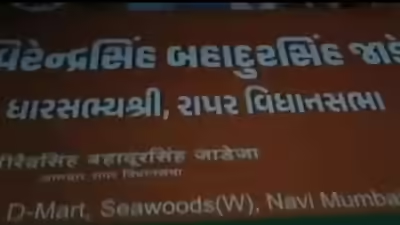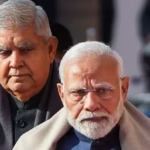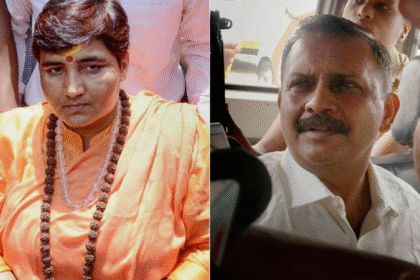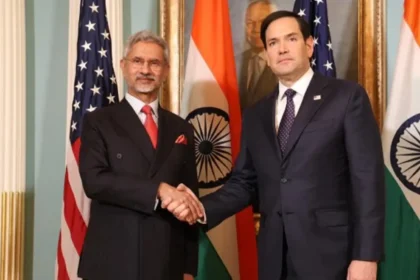Raj Thackeray’s MNS Workers Remove Gujarati Signboard from Navi Mumbai BJP MLA’s Office Under Police Supervision
Rising Tensions over Language in Maharashtra
In a striking development that has stirred linguistic and political debates across Maharashtra, workers of Raj Thackeray-led Maharashtra Navnirman Sena (MNS) forcefully removed a Gujarati-language display board from the office of a Bharatiya Janata Party (BJP) MLA in Navi Mumbai. The incident, which took place under police supervision, is not just a local skirmish—it is a reflection of the ongoing tensions around linguistic identity, regional pride, and political assertion in the state.
The act, captured on video and widely circulated on social media, showed MNS members marching into the office and pulling down the Gujarati signage. MNS leaders later confirmed that the action was deliberate, asserting their commitment to upholding the Marathi language in public spaces, particularly in government or political offices operating in Maharashtra.
The episode sparked immediate political reactions. BJP leaders condemned the act, calling it vandalism under the guise of regional advocacy. In contrast, MNS leaders defended their actions, saying they were simply following state signage norms that prioritize Marathi as the primary language in government and public institutions.
This event did not emerge in isolation. Raj Thackeray and his party have a long history of linguistic activism. The party has often positioned itself as a guardian of Marathi identity and has previously clashed with various entities over language use in signage, education, and governance.
Background of MNS’s Language Politics
The Maharashtra Navnirman Sena has, since its inception, used the Marathi language and identity as a central pillar of its political platform. Raj Thackeray, a charismatic and often provocative figure, has championed causes aimed at protecting what he calls the “Marathi Manus”—the common Marathi-speaking citizen. This cause has often put him at odds with migrant communities, especially those from North India and Gujarat, who have settled in large numbers in Mumbai and other urban centers of Maharashtra.
MNS’s recent actions in Navi Mumbai are not without precedent. In the past, the party has carried out similar protests against signboards in Hindi and English that fail to include Marathi. The difference this time lies in the language targeted—Gujarati. Given the historical ties between the Gujarati community and Mumbai’s commercial and political circles, the move carries significant symbolic weight.
For BJP, the incident is a political tightrope. The party has strong support among Gujarati-speaking voters, especially in urban areas like Mumbai, Thane, and Navi Mumbai. At the same time, it must maintain its broader appeal across linguistic lines in Maharashtra. The removal of the Gujarati board puts the party in a defensive position, trying to avoid alienating either of the two constituencies.
Meanwhile, the Shiv Sena (Shinde faction and UBT faction) has largely remained quiet, perhaps calculating its own response based on evolving political calculations ahead of upcoming elections.
Legal and Policy Context
The legality of language use on public signage in Maharashtra is governed by state policies and the Maharashtra Shops and Establishments Act, which mandates that Marathi be used prominently on signboards. The law does not ban other languages, but it stipulates that Marathi must appear in Devanagari script and be more prominent than any other language.
MNS has often argued that many offices and businesses flout this rule by prioritizing English, Hindi, or Gujarati. The Navi Mumbai incident is, according to MNS spokespeople, an act of enforcement in the absence of state action. However, critics argue that no political party has the right to unilaterally enforce such norms, especially not through direct action.
Legal experts suggest that while the prioritization of Marathi is lawful, the removal of signboards without due process could amount to unlawful interference, and potentially, trespass or vandalism. The fact that police were present during the MNS action in Navi Mumbai raises questions about the role of law enforcement—were they there to prevent violence, or did their presence signify tacit approval?
Community Reactions and Broader Implications
The Gujarati community in Navi Mumbai and beyond expressed disappointment and concern over the incident. Community leaders pointed out that Mumbai has always been a multicultural, multilingual metropolis. Actions that pit one linguistic group against another, they warned, risk unraveling the city’s social fabric.
On the other hand, Marathi advocacy groups have lauded the MNS move as a long-overdue assertion of cultural and linguistic primacy in the state. They argue that regional languages like Marathi are under threat in their own home due to the growing dominance of English and Hindi, and increasingly, other regional languages.
This linguistic flashpoint could have significant electoral consequences. As political parties vie for regional and cultural loyalties, incidents like this may be used to signal commitment to identity-based causes. However, the risk lies in alienating large segments of the population who see themselves as both proud Maharashtrians and part of India’s diverse mosaic.
Media Coverage and Narrative Building
Following the incident, media outlets across the country reported on the episode, each emphasizing different aspects of the event. Regional Marathi-language media largely framed the action as a bold and necessary assertion of linguistic rights. Headlines highlighted MNS’s commitment to defending Marathi identity and bringing attention to alleged violations of state signage laws.
In contrast, national English-language media provided a more balanced view, often framing the event within the larger context of identity politics and regionalism. News debates questioned whether such acts were constructive or divisive. Some analysts noted that while the emotional appeal of linguistic pride is potent, the means of enforcing it should remain within legal boundaries.
Social media played an equally influential role. Hashtags like #MarathiFirst and #LanguageRow trended on Twitter (now X), as users expressed both outrage and support. Memes, short clips, and local influencers weighed in, further amplifying the conversation. The debate soon reached beyond Maharashtra, with users from Gujarat and other states chiming in with their own perspectives.
Political parties too jumped on the media bandwagon. BJP spokespersons appeared on talk shows to condemn the act and assure the Gujarati community of their continued support. MNS representatives defended their actions by citing the law and accused the BJP of playing double standards—supporting regional pride in other states while opposing it in Maharashtra.
The media thus became not just a platform for reporting the incident but also a battlefield where narratives were shaped, reshaped, and contested. The power of visual storytelling—particularly the viral video of the signboard being removed—transformed a local incident into a national talking point.
Political Strategy and Pre-Election Significance
As Maharashtra inches closer to crucial state and national elections, every symbolic act is being closely watched for its political ramifications. The Navi Mumbai signboard incident has, perhaps unintentionally, turned into a rallying point for multiple voter blocs—Marathi speakers seeking cultural preservation, Gujarati communities desiring respect and inclusion, and broader audiences concerned with rising regionalism.
For the MNS, this act is more than just about a signboard. It is a calculated political maneuver aimed at reviving its influence, particularly in urban pockets where its traditional voter base has thinned over the years. By reigniting the Marathi pride agenda, Raj Thackeray is attempting to reestablish the party’s relevance and challenge the dominance of larger political players like BJP and Shiv Sena.
The BJP, on its part, faces a dual challenge—retaining its urban, business-friendly Gujarati support base while not appearing indifferent to Marathi cultural sentiments. Its handling of the fallout from this incident may very well influence its electoral performance, particularly in constituencies with mixed linguistic populations.
Shiv Sena, split into two factions, has thus far treaded carefully. The Uddhav Thackeray faction, traditionally rooted in Marathi pride, might find alignment with the emotional tenor of the incident, but is wary of being seen as supporting aggressive tactics. The Eknath Shinde faction, closely allied with BJP, must weigh the costs of taking a stand either way.
Smaller regional parties and independents are also expected to respond in due course, using the issue to either shore up regional loyalties or criticize the politicization of language.
Long-Term Cultural and Social Impact
Beyond the immediate headlines and political maneuvering, the Navi Mumbai language controversy reveals deeper undercurrents in Maharashtra’s evolving identity. At the heart of the matter lies the question: how can a pluralistic society balance the assertion of regional identity with respect for multicultural coexistence?
Mumbai, the state’s commercial capital, is a living mosaic of languages, religions, and ethnicities. Gujarati, Hindi, Marathi, English, and other tongues are heard daily in its markets, offices, and neighborhoods. Yet, this diversity often exists within a fragile equilibrium. Incidents like the one at the BJP MLA’s office threaten to disrupt that balance.
Educationists and sociologists warn that repeated flashpoints over language may discourage investment and migration, both of which are vital to the city’s economic and cultural growth. If citizens begin to perceive linguistic identity as a source of exclusion rather than pride, it could erode the social cohesion that binds the metropolis together.
On the other hand, some cultural commentators argue that periodic assertions of linguistic pride—when done respectfully and within the bounds of law—can foster renewed appreciation for local culture. The key, they suggest, is intent and method. Protests, if they aim to raise awareness rather than intimidate, can contribute positively to the democratic discourse.
In schools and colleges, the incident has already sparked student-led debates about identity, diversity, and the role of language in public life. Teachers report that students are asking thoughtful questions about the Constitution, state laws, and the principles of unity in diversity. This is perhaps the most constructive outcome of the controversy—a new generation reflecting on how to harmonize heritage with inclusivity.
Constitutional Framework and Linguistic Federalism
The confrontation between Marathi and Gujarati linguistic assertions in Navi Mumbai brings into sharp relief the delicate balance of linguistic federalism as enshrined in the Indian Constitution. At its core, India’s legal and political framework seeks to protect both regional languages and national unity, offering a model of coexistence rather than dominance.
The Constitution of India, through Article 343 and the Eighth Schedule, provides for Hindi and English as official languages of the Union while recognizing 22 regional languages, including Marathi and Gujarati, as scheduled languages. This multilingual scaffold ensures that states retain the autonomy to promote and preserve their linguistic heritage while aligning with national integration goals.
In Maharashtra, the status of Marathi as the official language is governed by the Maharashtra Official Languages Act, 1964, which mandates its use in official government communication and signage. This legal framework was further strengthened by amendments that insisted on Marathi in all administrative functioning at the municipal and panchayat levels. The Maharashtra Shops and Establishments (Regulation of Employment and Conditions of Service) Act, 2017, reinforced this by mandating Marathi signboards for all commercial establishments.
However, the law does not prohibit the use of additional languages—only that Marathi must be displayed prominently. Legal experts point out that this nuance is often lost in political discourse, where the assertion of linguistic identity sometimes morphs into antagonism against others. The Navi Mumbai incident is a case in point: while MNS claims to uphold the law, their unilateral removal of a Gujarati signboard—especially in a political office—could be viewed as overreach.
The courts have also weighed in on matters of language from time to time. The Bombay High Court has, in past rulings, affirmed the state’s right to prioritize Marathi in signage but has cautioned against coercive enforcement without legal due process. The judiciary has repeatedly emphasized the spirit of pluralism enshrined in the Constitution, advocating for enforcement mechanisms that do not infringe upon individual rights or inter-community harmony.
Language, in the Indian constitutional vision, is not just a tool of communication but a vehicle of culture, history, and identity. The challenge lies in ensuring that regional pride does not become a proxy for exclusion. In this context, the actions of political parties, law enforcement, and community leaders are crucial in interpreting and implementing linguistic policy with sensitivity.
As Maharashtra navigates the tensions between law, identity, and federalism, the larger question remains: Can the state evolve a framework where Marathi is celebrated without making other languages feel endangered?
Historical Parallels and Lessons from the Past
The language dispute ignited by the MNS in Navi Mumbai is not without precedent. India’s post-independence history is replete with conflicts around linguistic identity, each time revealing the deep emotional and political weight language carries in a diverse country. From the anti-Hindi agitations in Tamil Nadu during the 1960s to the formation of linguistic states under the States Reorganization Act of 1956, the battle over language has consistently shaped the nation’s federal structure, regional politics, and cultural consciousness.
In Maharashtra, the roots of linguistic assertion go back to the Samyukta Maharashtra Movement (1956–1960), which demanded a separate state for Marathi-speaking people. That struggle culminated in the creation of Maharashtra in 1960, with Mumbai as its capital—a symbolic and material victory for Marathi pride. Yet, decades later, Mumbai’s cosmopolitan character and economic magnetism have drawn in communities from across India, leading to the reemergence of anxieties about linguistic marginalization among native Marathi speakers.
The MNS, which emerged as a splinter group from the Shiv Sena in 2006, has tried to recapture the emotional energy of that original movement. Raj Thackeray’s repeated appeals to the “Marathi Manus” echo his uncle Bal Thackeray’s fiery oratory, but in a vastly changed socio-political context. Today’s Mumbai is more interconnected, multilingual, and aspirational than ever before. The challenge lies in channeling cultural pride without slipping into aggressive parochialism.
Comparisons are also being drawn between the current signboard episode and earlier MNS campaigns—such as the 2008 attacks on North Indian candidates appearing for railway exams, or the 2010 protests against English signboards in Mumbai. Each episode triggered intense public debate and political backlash, but also forced discussions on language policy, inclusion, and the definition of regional citizenship.
Experts point out that the lessons from these historical episodes are mixed. While linguistic pride can energize a political base, the fallout from aggressive enforcement can alienate other communities, spark legal consequences, and harm a party’s national image. Moreover, in an era of social media and instant virality, actions like tearing down a signboard are no longer confined to local memory—they become symbols replayed endlessly across screens, often detached from context and nuance.
The balancing act for regional parties, then, is to learn from history without repeating its more divisive chapters. Raj Thackeray’s MNS appears to be walking a tightrope: seeking visibility and relevance without tipping into political isolation.
Public Sentiment and Grassroots Response
As the Gujarati signboard takedown in Navi Mumbai continues to dominate headlines, it is not only political analysts and party spokespersons who are weighing in—ordinary citizens have begun to voice their perspectives with intensity and clarity. From Navi Mumbai’s residential complexes to social media timelines, the debate has stirred a range of emotions: anger, support, confusion, and calls for harmony.
For many Maharashtrians, the assertion for Marathi signboards is rooted in a legitimate concern: the fear that the language and culture of the state are gradually being diluted in their own land. They argue that in cities like Mumbai, Thane, and Navi Mumbai—where the demographic balance is rapidly shifting—Marathi should not merely survive but thrive. In this view, enforcing Marathi signage is not about excluding others, but about reclaiming space in the public domain for the mother tongue of the land.
“I am not against Gujarati or any other language,” said Anil Jadhav, a shopkeeper from Vashi. “But this is Maharashtra. At the very least, Marathi should be prominently displayed. What’s the harm in that?”
Others, however, see the incident through a different lens—one that places coexistence above assertion. Residents from the Gujarati community, which has had a long and economically influential presence in Navi Mumbai and Mumbai suburbs, have expressed discomfort over the manner in which the signboard was removed. For them, the optics of men storming into a political office and forcibly taking down a board sends a message of targeted intimidation, not cultural pride.
“Language is about identity, yes,” said Shruti Mehta, a college professor in Nerul. “But we need to ask ourselves—what kind of identity are we building if it’s based on erasing others? Gujarat and Maharashtra have shared a border and history for centuries. Let’s not let politics poison that relationship.”
On social media, especially on platforms like X (formerly Twitter) and Instagram, the issue has sparked viral debates. Hashtags like #MarathiPehle (Marathi First), #RespectAllLanguages, and #MNSPolitics trended intermittently, reflecting both sides of the argument. Influencers, regional content creators, and even stand-up comedians weighed in—some condemning the act, others supporting the language-first principle.
Interestingly, there has also been a parallel movement among citizens to de-escalate tensions. Local NGOs and inter-community cultural forums have begun organizing dialogues between Marathi and Gujarati youth to promote linguistic harmony. Some resident welfare associations (RWAs) in Navi Mumbai, representing mixed communities, have voluntarily updated their signboards to display both Marathi and Gujarati—an act of symbolic conciliation.
What this grassroots response indicates is that while language remains a powerful axis of identity in Maharashtra, there is also a strong undercurrent of inclusive sentiment. The average citizen—Marathi or Gujarati—is more interested in peace, development, and coexistence than in one-upmanship fueled by political calculations.
As the controversy simmers, the real test lies in whether political leaders, media houses, and administrative machinery can match the maturity of the people they claim to represent.
Also Read : PM Modi Reacts as Jagdeep Dhankhar Resigns as Vice President: ‘Got Many Opportunities to Serve the Country’








